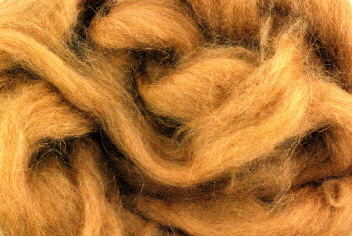|

Bactrian camels have two coats, a long and hairy outer coat and a soft and downy inner coat. Each adult camel produces about 2.5 kilos of down and another few kilos of coarser outer coat each year.
The outer fibre is used for making ropes and also strong yarn used in the warp of rugs. The inner down is considered a luxury fibre and it is very warm and light, it has some elasticity, but it is not very elastic. Camel down has a micron count of 17 to 19, and it is 25 to 75 mm long and it does not felt very easily. Use camel down when you want warmth without bulk, a characteristic that makes camel coats popular.
Camels shed their hair naturally every year and the fibre is shorn, gathered or combed. The inner coat is passed through a de-hairing machine, in the same way as cashmere, a slow and expensive process. Baby camel fibre is softer and lighter in colour than that of an adult, and it is more expensive. Baby camel varies from white to fawn, while the adults tend to be darker brown.
Baby camel is a great alternative to cashmere: it has a similar micron count but it is much more affordable. Camel fibre is also easier to dye with natural dyes as it is less likely to felt than cashmere. I find it more exciting to spin a fibre that comes from a camel that lives in the desert than cashmere that comes from a goat.
Camel down looks like a fluffy cloud and it is easy to spin long drawn, even without any hand carding. This is one of the warmest fibres I have spun, and my hands get quite hot holding the downy fibres. Camel tops are combed like wool tops and you can spin it anyway you like.
Blends can add elasticity and drape to a camel fibre that can sometimes be too hot on its own. For jumpers and hats, a blend of two thirds camel down and one third wool will produce a yarn with enough elasticity and without excessive warmth. For scarves, two thirds camel blended with one third silk produces a fabric with more drape and some lustre. For warmth, drape and elasticity, use a blend of one third camel, one third wool and one third silk. Brown Blue-faced Leicester wool and tussah silks are great for blending with camel.
By the way, camel hair brushes used by artists are mainly made with squirrel hair rather than camel.
Back to Alpacas and Camels
Back to Camels
Top of page
|

